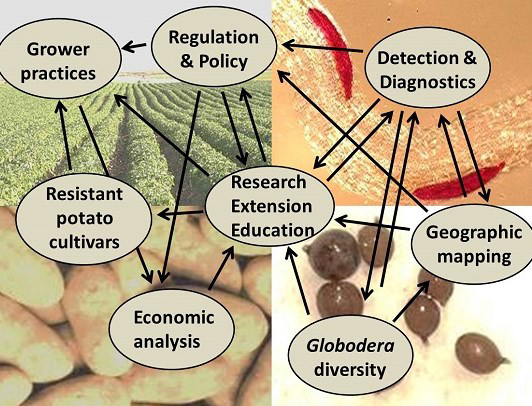1. Genomic approaches to risk assessment of Globodera. Understanding the molecular basis underlying virulence will inform detection and diagnosis, guide the deployment of resistance, and reduce the threat of new Globodera introductions. We will genetically characterize Globodera populations from the U.S. and other countries, using cutting-edge genomics technologies, and will link this genetic diversity to virulence variants and to pathotypes.
In Year 1, the following research has been conducted:
- A total of 120 Globodera spp. populations from around the worlds have been collected and are in the process of being characterized using a Genotype by Sequencing (GBS) approach.
- The genomes of two additional Globodera (G. ellingtonae and G. rostochiensis) were made available during the past year.
- A capture array was generated for effector sequences of G. pallida.
2. Enhance potato breeding for resistance to Globodera. We will develop molecular markers for resistance sources against Globodera and use these to accelerate the development of commercially acceptable varieties for the U.S.
Currently, two populations are being evaluated for potato cyst nematode resistance. One population with resistance to Race 1 of Globodera rostochiensis coming from parent cultivar Waneta is being tested against G. ellingtonae. The other population with resistance to three nematodes (G. pallida, G. rostochiensis, G. ellingtonae) with resistance coming from parent cultivar Eden. In this population, screening is continuing with 109 of a possible 200 individuals screened against the three species. After this resistance phenotyping, the whole population will be grown under commercial conditions in Aberdeen, Idaho and selection will be done at harvest for the best tuber type and shape.
Ongoing screening of other breeding lines and cultivars against all three PCN species is ongoing. Exchange of parental material with other programs is being done to obtain germplasm with G. pallida resistance. Crosses have been made at New York and Idaho programs using Innovator, a russeted variety with G. pallida resistance. Other resistant sources from the UK will be sought to add to the efforts currently underway.
Final results may be used to direct future work regarding mapping of quantitative traits and to explore gene copy number in resistant individuals.
3. Enhance stakeholder engagement, knowledge and action related to Globodera and consequences on the U.S. potato industry. Together with stakeholders, we will develop and disseminate innovative extension and outreach materials and presentations on the impacts of Globodera on trade relations, agriculture policies, economics, and potato production, to empower the potato industry to make optimal decisions to minimize adverse economic impacts to U.S. agriculture and food security. We will develop coupled models of nematode population dynamics x potato cropping system x pest economic impacts, to predict effects of susceptible vs. resistant potato cultivars on crop loss.
In the first year, we focused on launching the website, began a series of workshops at the Idaho Potato Conference to increase knowledge about the worldwide impact of potato cyst nematodes, and developed an assessment survey to gauge current attitudes and knowledge about this pest. We also hired a student that contributed toward presentations to Spanish-language clientele at the conference.
In Year 2, we are working to develop articles and updates for the GLOBAL newsletter and website on the use and management of litchi tomato as a trap crop. We also plan to develop an extension bulletin entitled ‘Preventing Introduction of Quarantine Pests’. A symposium on the ‘Worldwide Impact of Globodera’ was presented at the Society of Nematologists Annual Meeting in July, 2016.
4. Develop educational programs, using Globodera as a model, to teach concepts of ecological, agroeconomic, and global trade aspects of invasive plant pathogens. Our transdisciplinary project will incorporate several educational priorities, including increased participation of students in the agricultural and socioeconomic sciences, and enhanced understanding of the trade-offs implicit in effective but environmentally sound pest management.
Efforts in education will be made via recruitment of two new graduate students, and materials on Globodera and other quarantine pests will be developed for the University of Idaho grad student potato industry tour, scheduled for the spring of 2017.

